

F-86F
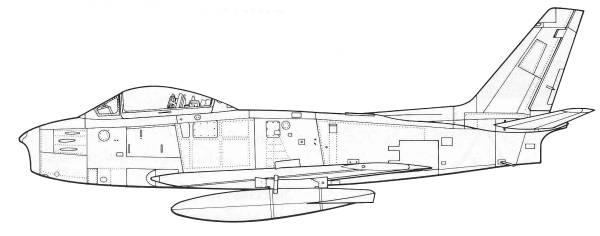
The F-86 Sabre design was initially quite similar to that of the first jet ordered by the Navy, the XFJ-1 Fury. The XP-86 fuselage was more slender and longer than the Fury but it retained the wing and tail of the Fury. Both the Sabre and Fury were to be powered by the General Electric J35 axial flow turbojet of 4000 lb. static thrust. The straight wing and the low thrust of the J35 restricted the XP-86 to a top speed of 575 mph which was below what the Air Force wanted. The end of WWII brought with it the jet technology from Germany. Captured documents of transonic wind tunnel data showed a speed benefit of using swept wing surfaces. It was estimated that using swept wing surfaces would increase the XP-86's speed by 75 mph. One problem with swept wings was loss of low speed handling characteristics but once again German data indicated that the use of leading edge slats improved low speed handling. With a new 35º swept wing and full span leading edge slats wind tunnel tests indicated the aircraft would have a top speed of over 650 mph. as a result the Air Force authorized building three prototypes in November of 1945.
The first prototype took a little over eighteen months to complete. It made its first appearance in August of 1947. The prototype had swept back wings and tail surfaces and bore little resemblance to its contemporaries, the P-80, P-84 and F9F. The XP-86 incorporated two major structural innovations, the use of tapered skinning and the use of a double skin structure that added strength and allowed enough open area in the wing for fuel tanks. The prototype flew on October 1, 1947 and flight tests revealed that the XP-86 was all that the Air Force had hoped for. Tests showed it was faster than anything else in service by 75 mph. North American re-engined one of the prototypes with the new GE 5,200 lb. static thrust engines and with this engine the XP-86 was put through the sound barrier on April 25, 1948, the first production aircraft to achieve this. At the completion of the test program the Air Force ordered the aircraft into production under the designation F-86A Sabre.
It is not the intent at this point to discuss in detail all the changes that occurred between the A model and the F which is the model to be built, just a brief look at how it progressed.
The F-86B was a modification to the original A which added larger wheels, tires and brakes which would have required modifying the fuselage. The Air Force signed a letter of intent to buy 190 F-86B's during 1947 however tire and brake technology advanced enough that the original tire and brake size could be retained and the order was changed to 188 A's and 2 C's.
The F-86C was designed to be a long range fighter to escort SAC bombers to Soviet targets. It retained the wings but had an entirely new fuselage and engine with side intakes, an area rule shape and radar in the nose. So drastic was the change that the Air Force redesignated it the YF-93. Only 2 were built as development of the jet bombers, the B-47 and B-52 eliminated the need for a penetration fighter and no more were built.
The F-86D was designed to fill the role of all weather jet interceptor. It had computerized flight controls, radar in the nose and a more powerful engine. It was armed with rockets instead of machine guns. Only 25% of the original F-86 was used. One major change was making the tail surfaces all flying, the entire horizontal stabilizer and the rudder were single pieces that that moved instead of have fixed surfaces with separate elevators and rudder.
The F-86E was an A model fitted with the all flying tail used on the D model.
The F-86F was the ultimate clear air, day fighter variant of the Sabre. It had a J47 engine with 5,910 lb. static thrust which increased speed and rate of climb. The F-86F-10 added a new radar ranging gun sight. The -25 and -30 variants added hard points to each wing to allow carriage of a second drop tank or 1000 lb. bomb and a redesigned wing with cord changes, a wing fence and no leading edge slats. The end result was a tighter turning radius at higher Mach numbers. At the peak of their service the Air Force had 16 wings equipped with the F-86F. North American built 1,959 of them. In addition Mitsubishi built an additional 300 of them for the Japanese Self Defense Force.
The Kit
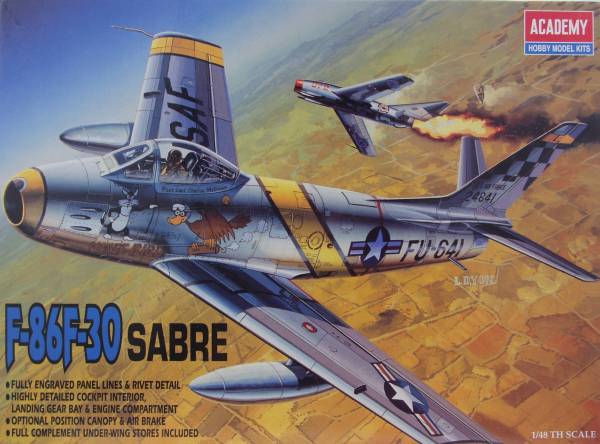
There are two good kits for the F-86, the Academy kit and the Hasegawa kit. After reading reviews of both I felt like the Academy kit had a few advantages that would work for me so that's the kit I chose. It comes in a sturdy two part top open box with nice artwork on the top. Inside the box one finds five sealed bags, all but one have two sprues per bag, the clear parts are in a bag by themselves. The kit is molded in a medium gray color with nicely engraved recessed panel lines and fastener and rivet detail.
The parts are nearly flash free with the smaller parts having a small amount of parting line to remove. Looking over the main structure parts I found only one sink mark on the left fuselage half below the speed brake that needs filled. The right half had only a faint mark which doesn't look like it needs filled. No other surface defects were found and the finish, while not highly glossy is smooth. I was hard pressed to find any ejector pin marks, Academy did a good job and even the usual suspects such as inside of gear doors and gear struts were free of them. I did find one on the nose gear retraction lever and several on the tail support stand. Only an issue if you plan to used it, I do not.
The kit has a fairly well detailed engine that can be displayed with the tail off and supported on the stand. The nicest feature about this it that the fuselage is molded in full left and right sides. To display the tail off it's necessary to cut along a thin spot in the fuselage. If you don't want to display the engine there is no fuselage joint that almost always needs work. Sweet design ! The kit comes with two pilot figures, one seated and one standing, both with a pose able part or two. The cockpit is not overly detailed with just the basics. The instrument panel has raised dials with raised internal detail but there is no decal for it. All of the flight control surfaces are fixed. Both sides have a separate panel over the machine gun bay that can be left off and machine guns to display if you do. The speed brakes are also separate so they can be posed open.
The kit comes with a variety of under wing items, two bombs and two each of two different style drop tanks, Sidewinder missiles are included but not shown in the instructions and would not be correct for the Korean War era. The wheel wells are boxed in and show some detail with the nose bay having the best level of detail. the kit wheels are not weighted. all together there are 140 pieces in gray. The clear parts are thin and clear and the canopy is molded in two pieces so it can be displayed open. There are 7 clear parts for a grand total of 147 parts. These can be seen below.
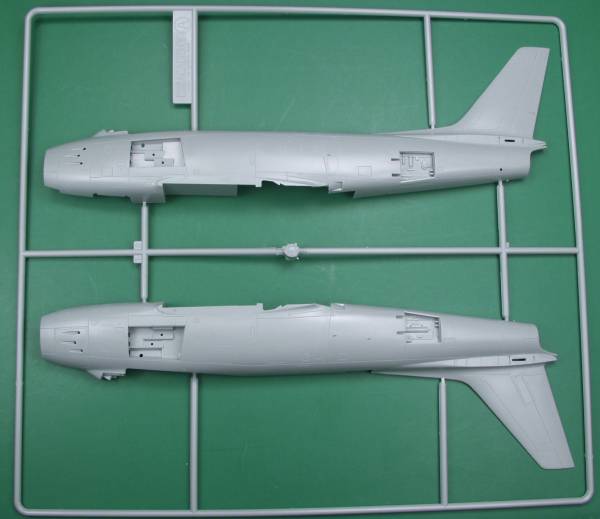
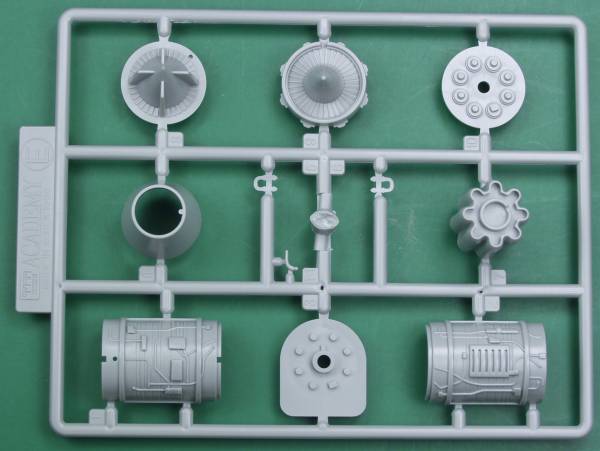
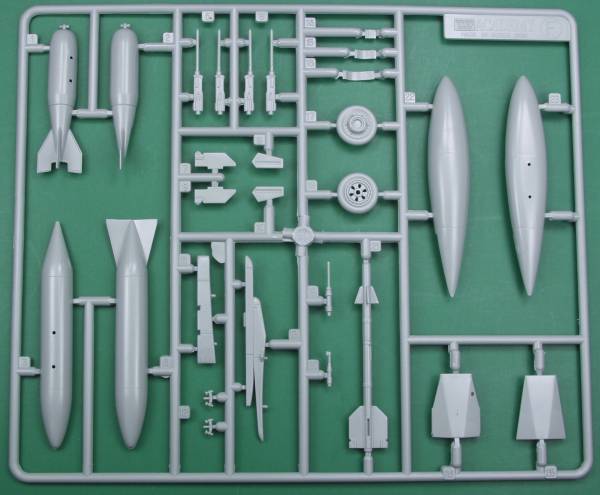
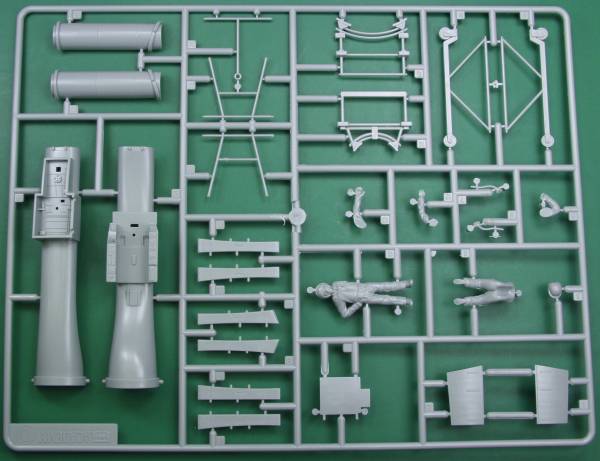
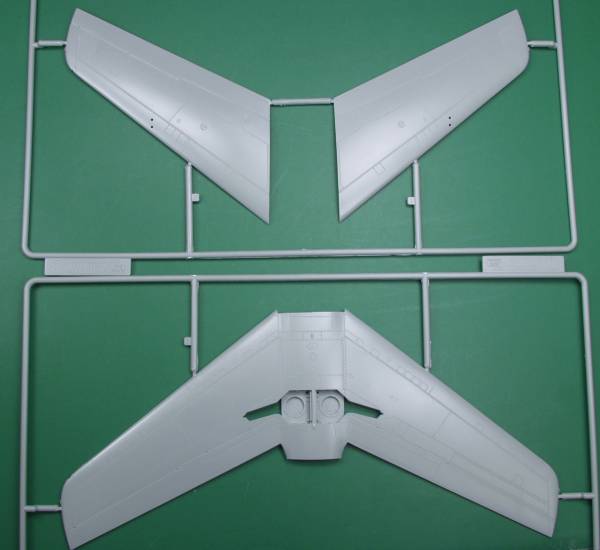
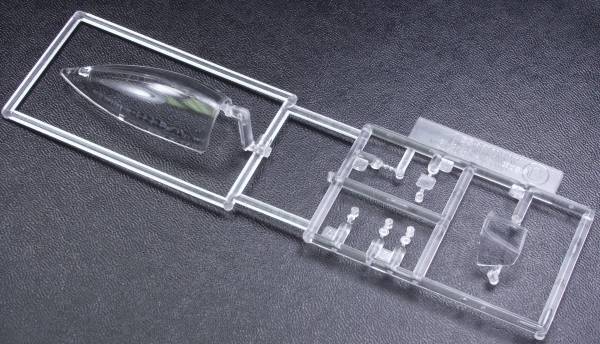
The decals are on a rather large sheet and has markings for two aircraft. The first is Capt. Charles McSwain of the 39 FIS / 51 FIW at Suwon, Korea, which is illustrated in the box top, the other is Lt. Harvey L. Brown of the 67 FBS / 18 FBW, Osan, Korea. The decals appear thin, well registered and look to opaque. They include a lot of stenciling and all of it appears to be readable. They also include all the other stripes and markings which usually give modelers fits and are generally best painted on. One note the decals for Mike's Bird on the sheet do not match the box art color wise. I'm not going on record as being knowledgeable on this and if you are sticker for detail you need to do some homework. When I decided to do this kit I picked up SuperScale's sheet 48-813 which covers this same aircraft. I have displayed both below and you can compare the differences between them and the box art for your self. If the box art is correct it would take parts from both sets to come close to it but I'm not branding the box art correct with out doing some research. See below.
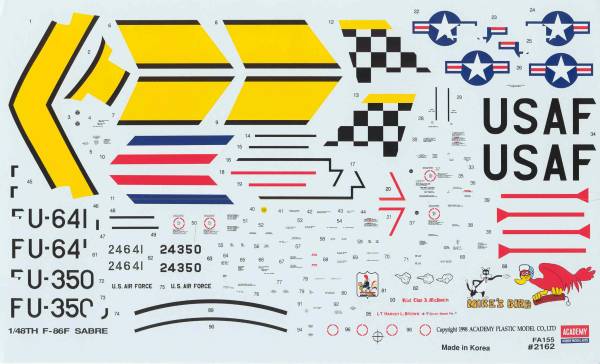
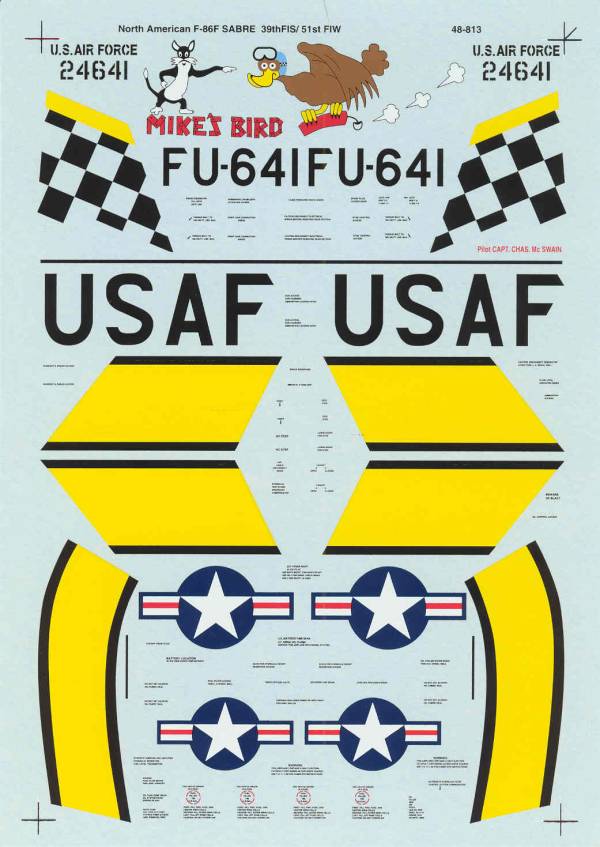
After Market Goodies
OK, so what sort of AMS goodies did I spring for on this kit ? Well I went easy for a change. First is the Eduard 48274 photoetch kit which is specific to this kit. The set predominately decorates the cockpit with seat parts, side console parts, replacement instrument panel with film, canopy slide rails and details for behind the seat under the canopy. The only external parts are drop tank fins, gun barrels and a part for the nose gear door. The fret and film can be seen below.
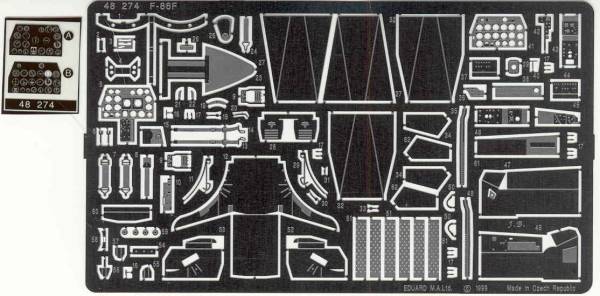
Next item was True detail wheels [48090]. These are weighed but don't appear quite as overly flat as some of their sets. See below.
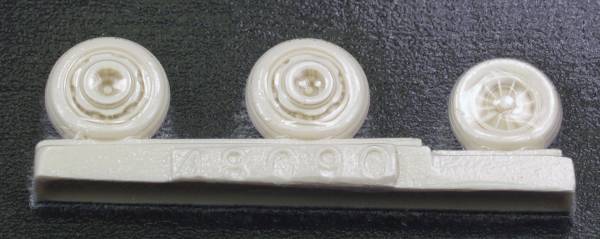
Next up is a seamless intake from Cutting Edge [CEC48217] This nicely molded piece eliminates the chore of making the seam go away from the inside of the kit parts. See photo below.
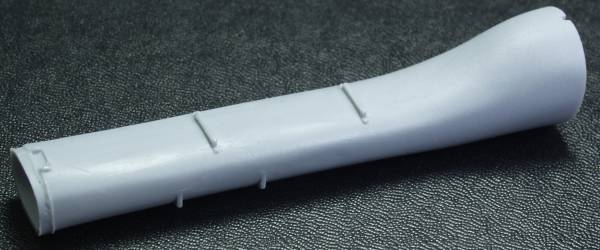
And last but not least a nose weight from Terry Dean.
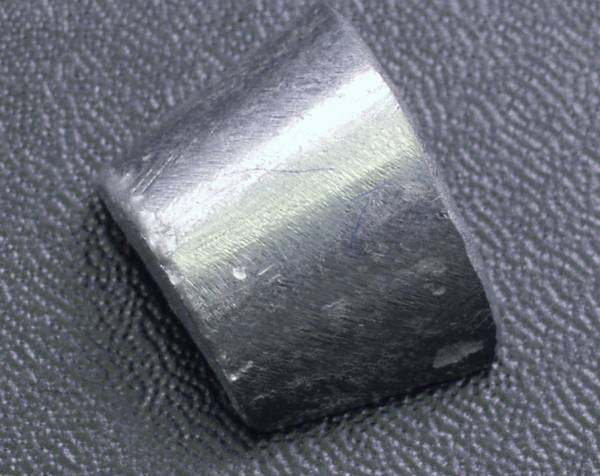
The instructions are printed on a 10 1/2" x 29 1/2" sheet folded to form 8 panels. Panel one is history in four languages followed by six panels of assembly, the last panel is a parts map. The is a separate A4 size page printed front and back with painting and marking instructions.
Links to kit build or reviews
References
Back to the POST WWII JETS page
Last updated 2/22/08